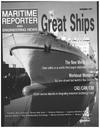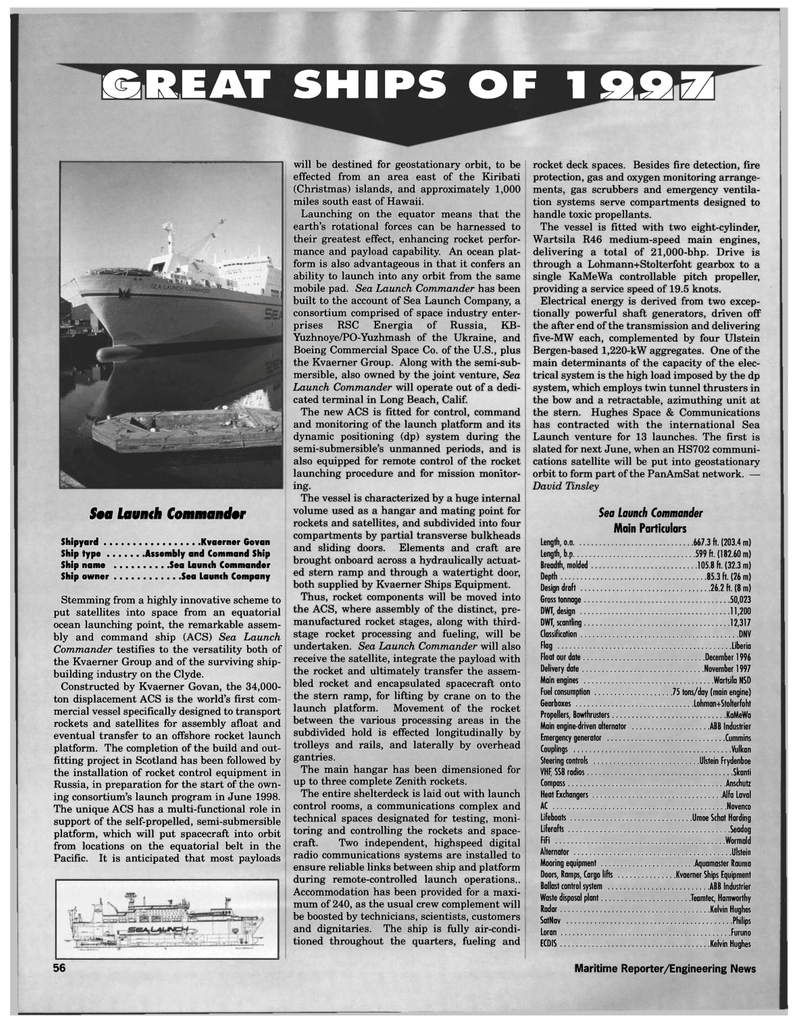
Page 57: of Maritime Reporter Magazine (December 1997)
Read this page in Pdf, Flash or Html5 edition of December 1997 Maritime Reporter Magazine
GREAT SHIPS OF 1 997
Sea laumh Commander
Shipyard Kvaerner Govan
Ship type Assembly and Command Ship
Ship name Sea Launch Commander
Ship owner Sea Launch Company
Stemming from a highly innovative scheme to put satellites into space from an equatorial ocean launching point, the remarkable assem- bly and command ship (ACS) Sea Launch
Commander testifies to the versatility both of the Kvaerner Group and of the surviving ship- building industry on the Clyde.
Constructed by Kvaerner Govan, the 34,000- ton displacement ACS is the world's first com- mercial vessel specifically designed to transport rockets and satellites for assembly afloat and eventual transfer to an offshore rocket launch platform. The completion of the build and out- fitting project in Scotland has been followed by the installation of rocket control equipment in
Russia, in preparation for the start of the own- ing consortium's launch program in June 1998.
The unique ACS has a multi-functional role in support of the self-propelled, semi-submersible platform, which will put spacecraft into orbit from locations on the equatorial belt in the
Pacific. It is anticipated that most payloads will be destined for geostationary orbit, to be effected from an area east of the Kiribati (Christmas) islands, and approximately 1,000 miles south east of Hawaii.
Launching on the equator means that the earth's rotational forces can be harnessed to their greatest effect, enhancing rocket perfor- mance and payload capability. An ocean plat- form is also advantageous in that it confers an ability to launch into any orbit from the same mobile pad. Sea Launch Commander has been built to the account of Sea Launch Company, a consortium comprised of space industry enter- prises RSC Energia of Russia, KB-
Yuzhnoye/PO-Yuzhmash of the Ukraine, and
Boeing Commercial Space Co. of the U.S., plus the Kvaerner Group. Along with the semi-sub- mersible, also owned by the joint venture, Sea
Launch Commander will operate out of a dedi- cated terminal in Long Beach, Calif.
The new ACS is fitted for control, command and monitoring of the launch platform and its dynamic positioning (dp) system during the semi-submersible's unmanned periods, and is also equipped for remote control of the rocket launching procedure and for mission monitor- ing.
The vessel is characterized by a huge internal volume used as a hangar and mating point for rockets and satellites, and subdivided into four compartments by partial transverse bulkheads and sliding doors. Elements and craft are brought onboard across a hydraulically actuat- ed stern ramp and through a watertight door, both supplied by Kvaerner Ships Equipment.
Thus, rocket components will be moved into the ACS, where assembly of the distinct, pre- manufactured rocket stages, along with third- stage rocket processing and fueling, will be undertaken. Sea Launch Commander will also receive the satellite, integrate the payload with the rocket and ultimately transfer the assem- bled rocket and encapsulated spacecraft onto the stern ramp, for lifting by crane on to the launch platform. Movement of the rocket between the various processing areas in the subdivided hold is effected longitudinally by trolleys and rails, and laterally by overhead gantries.
The main hangar has been dimensioned for up to three complete Zenith rockets.
The entire shelterdeck is laid out with launch control rooms, a communications complex and technical spaces designated for testing, moni- toring and controlling the rockets and space- craft. Two independent, highspeed digital radio communications systems are installed to ensure reliable links between ship and platform during remote-controlled launch operations..
Accommodation has been provided for a maxi- mum of 240, as the usual crew complement will be boosted by technicians, scientists, customers and dignitaries. The ship is fully air-condi- tioned throughout the quarters, fueling and rocket deck spaces. Besides fire detection, fire protection, gas and oxygen monitoring arrange- ments, gas scrubbers and emergency ventila- tion systems serve compartments designed to handle toxic propellants.
The vessel is fitted with two eight-cylinder,
Wartsila R46 medium-speed main engines, delivering a total of 21,000-bhp. Drive is through a Lohmann+Stolterfoht gearbox to a single KaMeWa controllable pitch propeller, providing a service speed of 19.5 knots.
Electrical energy is derived from two excep- tionally powerful shaft generators, driven off the after end of the transmission and delivering five-MW each, complemented by four Ulstein
Bergen-based 1,220-kW aggregates. One of the main determinants of the capacity of the elec- trical system is the high load imposed by the dp system, which employs twin tunnel thrusters in the bow and a retractable, azimuthing unit at the stern. Hughes Space & Communications has contracted with the international Sea
Launch venture for 13 launches. The first is slated for next June, when an HS702 communi- cations satellite will be put into geostationary orbit to form part of the PanAmSat network. —
David Tinsley
Sea Launch Commander
Main Particulars
Length, o.a 667.3 ft. (203.4 m)
Length, b.p 599 ft. (182.60 m)
Breadth, molded 105.8 ft. (32.3 m)
Depth 85.3 ft. (26 m)
Design draft 26.2 ft. (8 m)
Gross tonnage 50,023
DWT, design 11,200
DWT, scantling 12,317
Classification DNV
Flag Liberia
Float our date December 1996
Delivery date November 1997
Main engines Wartsila NSD
Fuel consumption 75 tons/day (main engine)
Gearboxes Lohman+Stolterfoht
Propellers, Bowthrusters KaMeWa
Main engine-driven alternator ABB Industrier
Emergency generator Cummins
Couplings Vulkan
Steering controls Ulstein Frydenboe
VHF, SSB radios Skanti
Compass Anschutz
Heat Exchangers Alfa Laval
AC Novenco
Lifeboats Umoe Schat Harding
Liferafts Seado
FiFi Wormald
Alternator Ulstein
Mooring equipment Aquamaster Rauma
Doors, Ramps, Cargo lifts Kvaerner Ships Equipment
Ballast control system ABB Industrier
Waste disposal plant Teamtec, Hamworthy
Radar Kelvin Hughes
SatNav Philip
Loran Furuno
ECDIS Kelvin Hughes 56 Maritime Reporter/Engineering News

 56
56

 58
58
